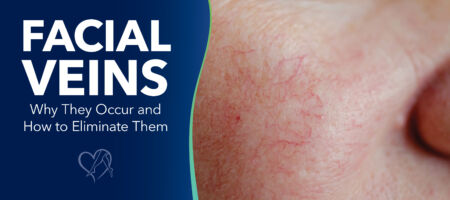
Medically reviewed by Khanh Q. Nguyen, DO, RPVI, and Sanjiv Lakhanpal, MD, FACS, on September 23, 2025
When most people think of spider veins or varicose veins, they picture the enlarged or web-like veins that typically appear on the legs, especially behind the knees. What many don’t realize is that spider veins can also form in other areas of the body, including the face. These small, red or purple vessels are not usually dangerous, but they can become a noticeable cosmetic change.
In this blog, we’ll explore what facial veins are, how they differ from varicose veins and vein disease in the legs, and why it’s essential to rule out underlying conditions before pursuing treatment. We’ll also discuss the professional treatments available that can safely eliminate visible veins once medical causes have been addressed.
Working to manage vein issues? Schedule a consultation with Center for Vein Restoration (CVR) today to learn about simple, professional solutions that last. Call our Patient Services Representatives at 240-965-3915 or click the button below to book a consultation at one of CVR’s 120+ vein clinics nationwide.

Facial veins are small, dilated blood vessels that become visible just beneath the skin’s surface. They are sometimes called spider veins, broken capillaries, or telangiectasias, the medical term for these tiny vessels. Unlike larger varicose veins that commonly appear in the legs, facial veins are usually smaller, flatter, and more superficial.
The difference comes down to both location and cause. Leg veins are often linked to chronic venous insufficiency (CVI), a condition where the valves in the veins do not work properly, causing blood to pool and veins to enlarge. Facial veins, on the other hand, are rarely tied to CVI. Instead, they usually develop from factors such as sun damage, genetics, or changes in skin thickness with age.
Even though facial veins are generally a cosmetic issue, it’s important to remember that they can also be associated with medical conditions requiring management in addition to, or instead of, cosmetic care.
For example, rosacea, liver disease, or even certain autoimmune disorders may present with visible veins on the face, so it’s always best to consult a primary care physician or dermatologist who can rule out these conditions. However, if you also experience swelling, heaviness, or discomfort in the legs, consult a vein specialist, since those symptoms can point to CVI.
In addition to medical conditions such as rosacea, a frequent cause of visible facial veins, there are several other reasons why these vessels appear. According to the Cleveland Clinic, rosacea is a chronic, lifelong condition affecting over 14 million people in the U.S., and facial veins are a common symptom. Beyond rosacea, a variety of other risk factors work together over time to make facial veins more visible and noticeable on the skin. The most common causes include:
Understanding these causes helps patients see that facial veins are not always within their control. Even with the best skincare habits, genetics and aging can still make them appear. And in some cases, particularly when rosacea or other medical conditions are involved, evaluation by a dermatologist or primary care physician is the best first step before considering cosmetic treatment.
Primarily a cosmetic concern, most facial spider veins are considered harmless. They usually appear as fine red, blue, or purple lines on the cheeks, nose, or chin. They don’t typically cause pain, swelling, or health complications, which is why many patients choose treatment for aesthetic purposes.
However, since conditions such as rosacea or systemic illness can also present with facial veins, it is essential to seek evaluation from a dermatologist or primary care physician before assuming they are only cosmetic.
The same can’t be said about varicose veins and vein disease in the legs; these conditions are very different, since varicose veins are almost always linked to CVI. Unlike facial veins, varicose veins can cause aching, heaviness, throbbing, swelling, and even restless legs. Left untreated, vein disease can progress to more serious problems, including skin discoloration, slow-healing ulcers, and blood clots.
At CVR, our physicians are trained to assess whether your visible leg veins are purely cosmetic or part of a larger circulatory health issue. This gives patients peace of mind and a clear path forward. Call our Patient Services Representatives at 240-965-3915 or click below to schedule a consultation and start your journey to better vein health.

Once a primary care physician or dermatologist has ruled out underlying medical conditions, treatment for facial veins can be considered. The good news is that problematic blood vessels, whether facial veins or leg veins, can be treated safely and effectively with modern techniques. Today’s vein care options are minimally invasive and designed to target the visible vessels without harming the surrounding skin:
It’s worth noting that home remedies like creams or cover-up makeup can only hide veins temporarily. They don’t treat the root cause. For lasting results, professional care is best: dermatologists can safely treat facial veins, and vein specialists like our CVR experts can address problem leg veins in a controlled, medical setting.
📞 Call Center for Vein Restoration at 240-965-3915
📅 Or book online HERE
While facial veins are often a cosmetic concern treated by a dermatologist solely for aesthetic purposes, varicose veins and vein disease in the legs should never be ignored. Over time, unaddressed vein disease can progress and limit mobility, reduce quality of life, and lead to complications that require more advanced care.
If you are ready to explore safe and effective options for vein treatment, schedule a consultation with CVR today. Whether your symptoms are cosmetic or have progressed to physical, our compassionate team of vein care specialists will help you find the best solution for your unique needs so you can feel comfortable once again. Call our Patient Services Representatives at 240-965-3915 or click below to book your consultation online.
